Jaipur
Jaipur – Rajasthan , the glistening Pink City, was founded by and named after Sawai Jai Singh II. It beckons tourists with a magnificent display of its royal Rajput heritage in its imposing forts and impressive palaces. Added bonus is the warm hospitality of its colorful people and of course a plethora of handicrafts to shop for. Tourists can enjoy watching and participating in various festivals that Jaipur hosts-from the modern Jaipur Literary festival to the traditional Teej, Gangaur and Kite festival. Summers are very hot in Jaipur, with temperature almost 45°C while the winters are cool and ideal to plan for a holiday, although the temperature may dip down to 8.3°C in winter.

Amer Fort
History & Culture Popularly known as Amber Fort, this beautiful fort built by Maharaja Man Singh depicts the artistic Hindu architecture through its cobbled pathways and large entrances. This four-level fort, built with red marbles and sandstone, consists of the royal legacy of Diwan-e-Aam, Diwan-e-Khas, Sheesh Mahal, Sukh Niwas (water cascades making wind blow to create an artificial cool weather) and a temple of Sila Devi. For generations, the royal families used to stay here, and it was secretly connected to the Jaigarh fort for emergency escapes during attacks

Jaigarh fort
History & Culture This beautiful creation by Maharaja Jai Singh, located at Amber, Jaipur stands on the Cheel Ka Teela (Hill of Eagles), a promontory of the Aravalli Hills. Located 400 metres above and similar in structure with the famous Amber Fort, it was meant to protect the latter. One can reach the Amber Fort through the secret subterranean passage from Jaigarh Fort. This fort is 3 km long and 1 km wide. It has the world’s largest cannon on wheels, called Jaivana; a few palace complexes which served as the residences of the royal families; a well maintained garden; and a museum

City Palace
This gigantic fort includes two more forts inside, and is located on the north-east part of Jaipur. City Palace was the seat of the kings. It has a huge array of buildings, courtyards, temples and gardens. Its construction was started by Jai Singh following a perfect blend of Indian and European styles of architecture. The magnificent grid pattern encloses Mubarak Mahal, Chandra Mahal, Mukut Mahal, Palace of Maharani, Govind Temple and City Palace Museum. Chandra Mahal, one of the inner forts of City Palace, has a museum of its own and is still a residence of the royal family members.

Hawa Mahal
Hawa Mahal, or the Palace of Winds, built by Maharaja Pratap Singh, is located on the southern part of Jaipur. This beautiful five-storeyed building, designed to replicate the crown of Lord Krishna, looks like a honeycomb having about 1,000 small windows. These have latticework that encouraged cool air or doctor breeze to enter the palace, air-conditioning the whole area during the summers. The pink and red sandstone on the exterior gives it a magnificent look in the morning. The palace is part of the royal City Palace extending till the Zenana or the chambers of women.

Nahargarh fort
History & Culture Standing on the edge of the hills of Aravalli, the Nahargarh Fort gives a mesmerizing view of the pink city of Jaipur. Nahargarh literally means “abode of tigers”, evoking the royal legacy of Rajasthan. Maharaja Sawai Jai Singh, who founded Jaipur, built this fort. The fort has been part of important historical events: treaties of the Marathas were signed here, and it was the refuge of British women during the Sepoy Mutiny. The fort served as a hunting residence for the kings. The rooms of this beautiful fort are linked with long corridors

Jantar Mantar
History & Culture Built by Maharaja Jai Singh, this observatory, officially declared as the national monument, has a huge collection of astronomical instruments. Beautifully crafted in marble and local stone, it is one of the largest buildings in the country that is dedicated to the exploration of celestial bodies. It consists of around 14 fixed and focused devices that measure time, predict eclipses, track stars, and locate earth orbits around the sun..

Jagat Shiromani Temple
This beautiful temple was erected by the mother of King Jagat Singh, Shringar Devi Kankawat and the construction took nine years to complete, from 1599 to 1608. The west-facing temple is dedicated to the Hindu gods Radha and Krishna, and the building consists of a gaduda chatri, marble torana, a vestibule, a square sactrum crowned with sikhara, a mandapa that lies on a decorated pitha followed by the jangha and vedibandha. The holy mandap has several pillars decorated with lateral transepts and a vaulted ceiling with religious paintings.

Jal Mahal
History & Culture Literally translated to “Water Palace”, this beautiful architecture is situated in the middle of a lake called the Sagar Lake, in the city of Jaipur. Both these were renovated as well as enlarged by King Jai Singh in the 18th century. The halls inside the palace at the first floor are well decorated, but cannot surpass the aromatic beauty of the Chameli Bagh upstairs. The area is surrounded by the Aravallis, other forts, temples, and mesmerizing natural beauty. The lake has well established drainage system, required depth for fishes to be alive, and five man-made islands for attracting migratory birds
